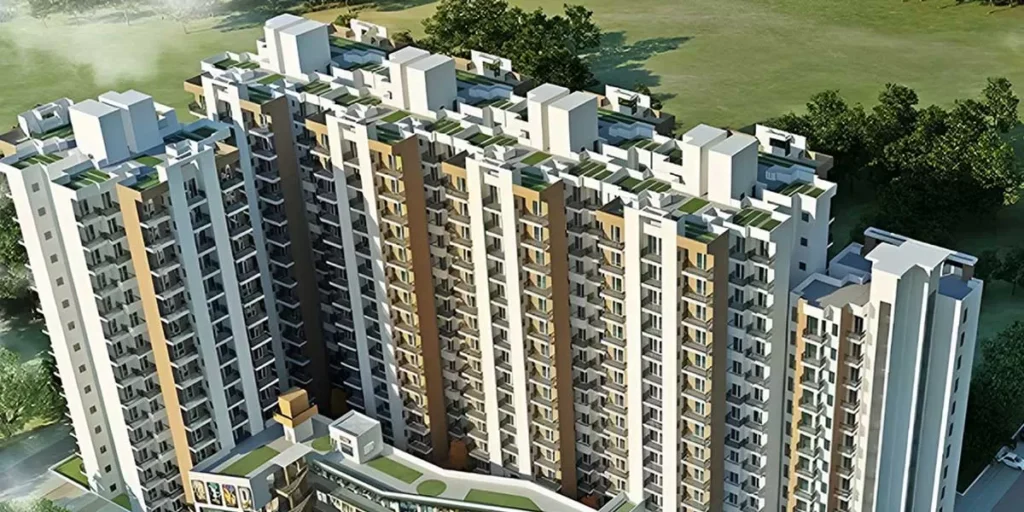The Boom: Fact or Fantasy?
India’s bustling satellite city just southwest of New Delhi—is in the midst of a dramatic luxury housing wave. In 2024, new luxury real estate launches in Gurugram soared to ₹88,000 crore—nearly double 2023—despite a drop in the number of projects from 239 to 124 . Average prices have skyrocketed too, rising 84% since Q1 2020—an annual increase of around 30% in 2024 .
Major developers like DLF, Godrej Properties, Sobha, Signature Global, and M3M banked on this surge. One standout example: DLF’s “The Dahlias” project sold 173 units worth $1.4 billion in just nine weeks, while its Privana North fully sold out for $1.3 billion in a week

What Is Fueling the Boom?
1. Real Demand from End Users
Some experts believe the demand is largely genuine. Signature Global’s CEO Pradeep Kumar Aggarwal recently stated that around 60% of homebuyers in their projects are actual end-users, not investors looking to flip properties. He also mentioned a very low cancellation rate of under 5%, which indicates serious buyers rather than speculative ones.
DLF’s Chief Financial Officer Ashok Tyagi echoed similar views. He said that very few buyers are re-selling properties in the secondary market, showing long-term commitment from buyers.
2. Strong Interest from NRIs
NRIs have become a strong force in Gurugram’s real estate market. With the Indian rupee weakening against the US dollar, property in India is now more affordable for NRIs. In many luxury projects, they make up around 20-25% of the total buyers. These are individuals looking either to return to India in the future or to invest in high-growth assets.
3. Limited Land and High Infrastructure Growth
Gurugram’s physical infrastructure has improved significantly in recent years. Projects like the Dwarka Expressway, the Southern Peripheral Road, and better metro connectivity have made once-remote areas more accessible. At the same time, land supply in the prime parts of Gurugram is limited. This combination of high demand and low supply naturally pushes prices upward.

Warning Signs: Are Prices Rising Too Fast?
Despite the positive signs, many analysts and homebuyers are beginning to worry. A few red flags point to the possibility that this might not be a sustainable boom.
1. Declining Sales Volume
While total investment in projects is rising, the actual number of homes sold is not keeping pace. Home sales in Gurugram reportedly dropped 16% year-on-year in late 2024 and even more in early 2025. Fewer people are buying, even though prices and project values are growing. This mismatch could indicate that the market is overheating.
2. Affordability Is Falling
A typical 3 BHK luxury apartment in Gurugram now costs between ₹4 crore and ₹8 crore. That’s far beyond the reach of most middle-class families. Many potential buyers feel left out, and first-time buyers are especially frustrated. Some believe that property is no longer a realistic goal unless bought purely as an investment.
3. Speculative Buying Still Exists
Although developers claim that most buyers are end-users, there are still signs of speculative activity. Some industry observers have noted that many units are being bought during the pre-launch phase and quickly flipped for a profit once prices rise. This kind of quick turnover has historically been linked to real estate bubbles.
Government’s Concern and Market Regulation
To cool down the fast-growing market, the Haryana government recently froze the circle rates—the government-declared minimum value for property transactions. This move aims to prevent sudden hikes in property values and reduce tax evasion, but it also signals that authorities are aware of the overheating market.
Some experts argue that unless stricter regulations are enforced, speculative activity could increase again, especially if interest rates remain stable and investors feel confident.
Developer Outlook: Confidence with Caution
Top developers, including DLF, Signature Global, and M3M, maintain that the growth is sustainable. They are planning more launches and expanding into new sectors within Gurugram. However, even they are adjusting their strategies. Some are shifting toward smaller luxury units to cater to mid-level buyers who want high-quality housing but at a more manageable price.
There is also greater emphasis on providing better amenities, green spaces, and smart technology features to justify the premium pricing.
Expert Opinions: Boom with Risks
Most property consultants agree that Gurugram’s market is undergoing a transformation. While infrastructure and business growth support rising demand, the sharp price surge cannot continue forever.
Property expert Anuj Puri from Anarock has warned that although luxury demand is strong now, developers need to avoid oversupply. If too many projects are launched too quickly, especially at high prices, buyers could pull back. That could lead to falling prices and stalled projects.
What Should Buyers Do?
If you’re thinking of buying a home in Gurgaon – Wikipedia—especially a luxury one—experts suggest the following:
- Buy for long-term use, not quick profit. Don’t expect prices to rise forever.
- Choose trusted developers with a good delivery record.
- Understand the full cost, including registration charges, maintenance, and taxes.
- Avoid rushing into pre-launch offers that promise big returns.
- Wait if you’re unsure. The market could stabilize or correct in the next couple of years.
Conclusion
Gurugram’s luxury housing market is currently booming, driven by infrastructure growth, NRI demand, and a premium lifestyle appeal. But the rapid price rise, affordability issues, and signs of speculation mean that caution is necessary.
This is not yet a bubble—but it could become one if supply continues to rise faster than demand, or if buyers lose confidence. For now, the boom appears to be real, but sustainability will depend on balanced growth, responsible development, and transparent pricing.
Also read: 15 Eco-Friendly Product Alternatives You Can Start Using Today










Leave a comment